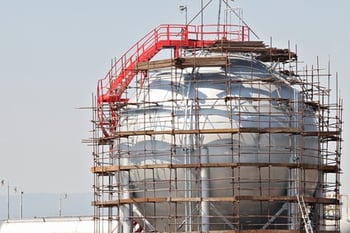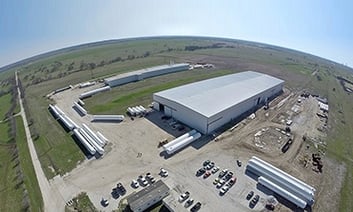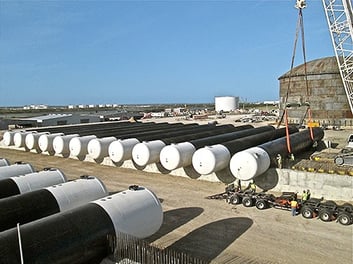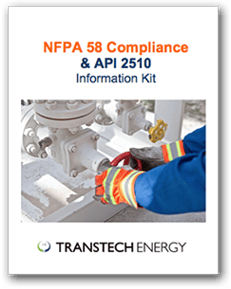Large Volume LPG Storage Options
The remarkable growth in U.S. propane output has led to a surge in demand for related storage capacity, from the wellhead to all points across the supply chain, both domestically and around the globe.
On its own or in combination with butane, propane is readily liquefied under pressure to form LPG (liquefied petroleum gas). At volumes 250 reduced from its natural state, LPG can be efficiently—and economically—transported via truck, rail, barge or ship, making it particularly ideal and in demand for rural and other remote, off-grid locations.
Unlike natural gas (methane), LPG can be relatively quickly deployed to its point of use without the need for pipeline infrastructure, but does require significant storage capacity at points across the supply chain to buffer demand fluctuations and accommodate intermodal transportation management.
Storage options include spherical LPG pressure vessels and both above ground and underground (‘mounded’) cylindrical vessels, also called bullet tanks. For decision-makers charged with the responsibility of procuring large volume storage for LPG supplies, understanding the pros and cons of spherical LPG vessels versus bullet storage tanks will help ensure the right choice is made.
Land/Space Requirements
 The first spherical LPG pressure vessels or ‘Hortonspheres’,
The first spherical LPG pressure vessels or ‘Hortonspheres’,
as they are also known, were built by the Chicago Bridge & Iron Company (CBI) in 1923. With their unique, entirely rounded profile, Hortonspheres allow for efficient, large volume storage of compressed gases in a liquid stage.
With typical capacities ranging from 10,000 to 75,000 barrels (approximately 300,000 to over 2,000,000 gallons) one of the most significnt benefits of using spherical storage tanks is the ability to hold very large liquid volumes within a proportionally small amount of space.
In other words, the ‘footprint’ needed for a Hortonsphere is considerably smaller than that needed for the number of storage bullets required to accommodate an equivalent volume.
Time to Market, Time to Money…
One of the drawbacks of the Hortonsphere is the amount of time required for fabrication, which can be up to 12 -18 months in some cases. Due to transportation limitations, these large vessels must be fabricated in sections off-site and then completed in the field. The process requires significant time and coordination to ensure proper staging, sequence of assembly and welding—with continual on-site testing throughout the on-site construction process.
The fabrication of LPG storage bullets on the other hand, can be completed entirely off-site, in a controlled environment. Reputable tank manufacturers deliver all tanks pre-tested and certified, National Board code stamped and registered, making in-field implementation a more predictable and faster process. Lead times for bullet tanks are typically in the 8-12 week range.
entirely off-site, in a controlled environment. Reputable tank manufacturers deliver all tanks pre-tested and certified, National Board code stamped and registered, making in-field implementation a more predictable and faster process. Lead times for bullet tanks are typically in the 8-12 week range.
With capacities of up to 120,000 gallons per tank and more, multi-tank batteries, or ‘tank farms’, can readily accommodate large-scale storage needs. For example, a tank farm consisting of ten to twenty-five 120,000 gallons vessels provides immediate storage for 1,200,000 to 3,000,000 gallons
For projects with tight delivery schedules—that can accommodate the land space requirements—LPG storage bullets provide faster time-to-market—and faster time-to-money.
Cost
Because Hortonspheres generally hold more volume per vessel than cylindrical storage bullets, less overall piping will be needed for the interconnection of vessels on site, which can reduce overall project costs.
Additionally, mathematically speaking, the spherical shape delivers the smallest possible surface area per unit of volume than any other shape. Because of this, the overall coating/painting cost per unit of volume is also lower for spherical vessels than for cylindrical tanks.
Finally, the spherical shape also offers the most uniform stress resistance, which allows for a thinner wall. Thus materials cost per unit of volume is also lower for spherical vessels.
All of this said, the high in-field fabrication costs of spherical vessels can offset these savings. Long-term cost considerations need to take into account the fact that, from an economical standpoint, it is not tenable to relocate an LPG storage sphere. Just as their initial fabrication must be done in pieces, relocation would call for the disassembly of the sphere into sections, which would then need to be transported and reassembled at a new site. The costs involved in ensuring a relocation effort that results in a safe, operational vessel are roughly the equivalent of investing in an entirely new storage sphere, making relocation a zero-sum game.
Typically, used storage bullet tanks on the other hand can be readily relocated, refurbished, and sold at attractive market rates.
Safety
 One advantage to spherical vessel construction is that the stress concentration for stored LPG is both more uniform and lower than that within a cylindrical shaped bullet. Also, because they have a smaller surface area per unit of volume, the quantity of heat transferred from warmer environments to liquid stored, will be lower than that of bullets.
One advantage to spherical vessel construction is that the stress concentration for stored LPG is both more uniform and lower than that within a cylindrical shaped bullet. Also, because they have a smaller surface area per unit of volume, the quantity of heat transferred from warmer environments to liquid stored, will be lower than that of bullets.
However, the chance of failure and collapse for a large spherical vessel is greater than that for bullet tanks, as the overall load - for an equivalent volume of liquids stored – is concentrated in a single vessel rather than being distributed over a larger area as when stored within a battery of smaller sized tanks (serving the same total volume.)
The use of multiple storage bullets also reduces the possibility of uneven settlement—another potential cause of vessel failure—again, by dividing the overall load into lesser volumes.
Particularly for geographies prone to natural disasters such as earthquakes, hurricanes or tsunamis, including islands and areas where powerful colliding warm and cold air masses (and resultant tornados) are more common, a battery of multiple storage tanks offers lower risk of failure than large-scale spherical storage vessels.
Maintenance & Shut-Dow
One of the strongest arguments in favor of choosing a battery of bullet vessels over one or more spherical vessels when possible, is the consideration of ongoing maintenance—including both planned and unexpected shutdowns.
With tank batteries, any maintenance or repair issue that calls for the shutdown of a tank is limited to the tank involved. The particular tank can be shutdown and repaired while the remaining tanks continue at full operation.
With the use of larger capacity spherical storage, the shut down of a single vessel can halt operations entirely, leading to potentially astronomical additional costs associated with halting both incoming and outgoing product.
Further to this, if it becomes necessary to empty the vessel at hand, the contents of a smaller size bullet vessel can be fairly quickly deployed to another vessel on site. The task of addressing upwards of a million(s) of gallons of LPG within a single spherical vessel on the other hand, is a far more onerous task, with an extended period of shut-down to be expected.
Which Choice is Best for Your Project?
When space allows, bulk bullet tank storage provides an ideal solution for supporting high levels of LPG consumption—while supporting faster project delivery, lower overall risk, ease of ongoing maintenance and operations.
Our above ground storage tanks are available in an array of sizes of up to 120,000 gallons and more. For large installations and terminals, multiple tanks can be linked together to serve any need. Underground tanks are also available.
We also offer custom engineered and turn-key solutions and services for LPG storage and transfer including bulk plant and terminal design, engineering and construction; both new and used LPG storage bullet tanks; custom vessel specification, design and fabrication; logistics coordination; field services including installation and training; field maintenance; startup and commissioning.
Speak with on of our experts today to learn more: (+1) 888-206-4563






